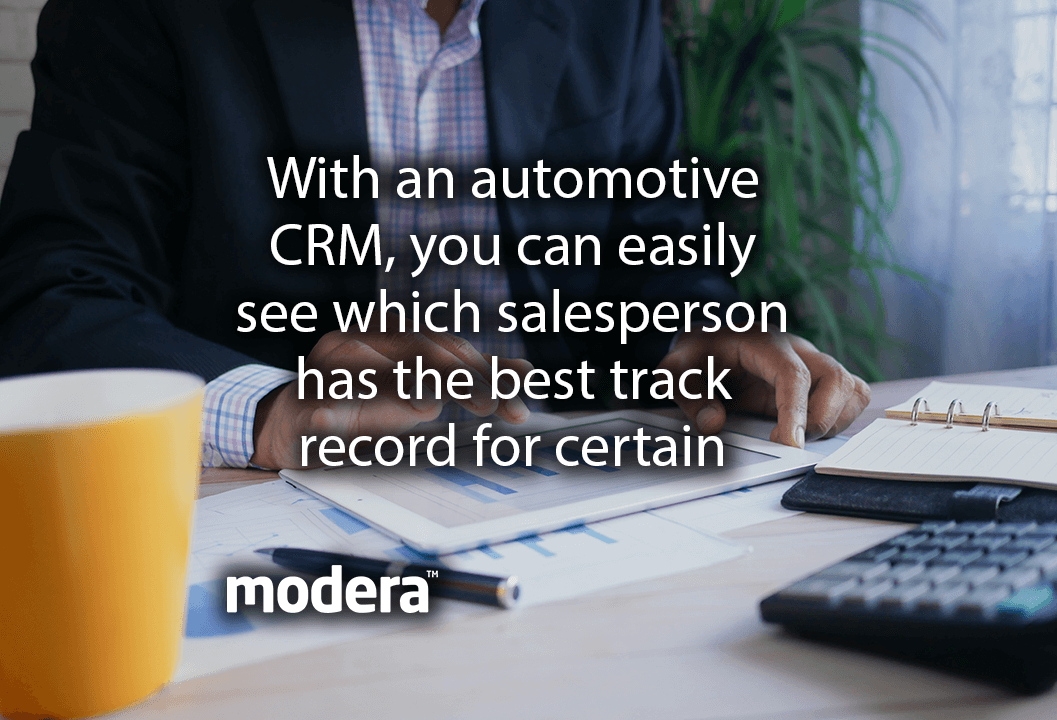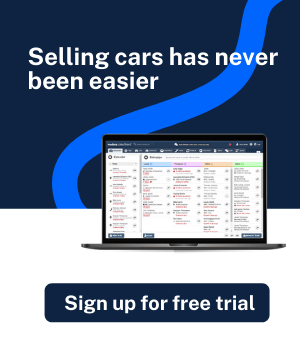
Looking to get more profit from your dealership, while building long-lasting relationships with customers? Of course, that is the end goal isn’t it? But, it is definitely easier said than done, because in order to accomplish that, you need to be more efficient and productive. One of the best productivity tools for dealership managers is an automotive CRM. With an automotive CRM software, such as Modera, you can easily automate tasks that let you boost the bottom line and get more done at the same time.
What is automotive CRM software?
To put it in a nutshell, an automotive CRM is a customer relationship management software that lets you organize and understand data much better, which comes from existing customers and leads. All of this information is presented on a dashboard that allows you to see just about every aspect of your operations. It helps to automate processes and keeps others in the dealership updated about them as well.
An automotive CRM lets you manage several data points such as current leads, existing sales, ad media placement, ad spends, performance of sales reps, conversion rates, ROI, and much more. Of course, there are a number of other data points that will be at your fingertips. With an automotive CRM system, you will be able to organize this information to help you reach your dealership sales goals. It has the following benefits:
Excellent customer experience
It is much easier to provide a positive buying experience when you know a lot about your prospect. Seeing at a single glance every blog post, email, and ebook they have opened or read, as well as key details like their company’s size, location, and vertical, gives you a major leg up. You can personalize your messaging and provide more value from the start.
More productivity
As mentioned, with a CRM, you can automate tasks such ascall and activity logging, reporting, deal creation, and more. The less time that salespersons spend on administrative work, the greater number of hours they have, to get in front of prospects. Your revenue will increase accordingly.
Clearer insights
Want to find out how your salespeople are doing? A CRM gives you a clearer picture both on-the-ground and on a higher level, of rep performance, including team-wide and individual conversion rates by deal stage, average deal size, deal velocity, and much more. Just think what you could achieve with valuable data – it could help you understand what works and what doesn’t.
Better collaboration between teams
A sales manager can instantly see how and when her salespeople are reaching out to and following up with buyers. An account executive can quickly fill themselves in on an opportunity a sales rep has prospected and qualified for them. Salespeople on the same team can learn more about each other’s best practices and pinch-hit for each other whenever someone goes on vacation or gets sick. To sum up, a CRM boosts rep collaboration and efficiency.

How to stay up-to-date with dealership processes?
1. Managing day-to-day operations
Managing a dealership means simultaneously juggling several tasks. Chances are that you have a giant whiteboard where you try to best organize what needs to be done in a day! While it gives you an overview of dealership managerial tasks, an automotive CRM lets you view the information in a centralized manner, to give more options.
For instance, you might have a huge Memorial Weekend sales event coming up. There are chances you might have to deviate from the usual routine to handle the increased foot traffic and workload. With an automotive CRM, you can better organize what needs to be done for that crucial sales weekend.
So basically, you can quickly organize and see what has to be done in a day, make adjustments to your schedule to accommodate the unexpected, and set up special workflows for specific projects or events such as holiday sales.
2. Assigning leads
Leads are everything! You have to spend lots of time and money to ensure that the dealership gets solid leads. Now comes the tough part – converting them into sales. You have to ensure that the leads go to the right salesperson or it becomes worthless. With an automotive CRM, you can easily see which salesperson has the best track record for certain types of leads.
A CRM leads you view individual performance, so you might have a salesperson on your team who knows how to close SUV sales to women, more successfully, as compared to others on the team. Maybe, you have a salesperson who is really good at handling sales to first-time buyers under the age of 30. The automotive CRM helps to put leads into the right hands. When you have to handle dozens of leads every day, automation of this task can be handy.
The automotive CRM assigns leads to the right sales personnel, lets you track which of them is the most successful with particular types of leads, and finally, allows you to keep tabs on the performance of each lead.
3. Segmentation of lists
Chances are that your dealership has a list of hundreds or even thousands of leads and existing customers. However, the big pile of customers and leads can be more useful if you can segment them into helpful lists. With an automotive CRM, you can quickly segment the list in any way that you please. It will let you better organize your leads and customers for marketing and sales purposes.
For example, you get to categorize leads according to high-income zip codes and lower-income zip codes. You could also make a list of existing customers who drive SUVs vs. those who lease sedans. When lists are segmented, you can better target specific vehicles and particular customers.
Steps to implement this:
- Quickly create lists of customers by income, demographics, and vehicle preference.
- Create lead lists for each sales associate.
- Segment lists for targeted email/text campaigns.
4. Marketing efforts
It won’t be an exaggeration to say that marketing can make or break a dealership. It is necessary to know where to find the right marketing and advertising opportunities are that bring in the best ROI. An automotive CRM lets you track performance of all marketing channels, based on cost per head and cost per sale.
For example, you can see which Facebook ads or YouTube ads are giving you the best bang for your buck. The CRM lets you view split testing results on ad executions on a single platform. Thus, you can focus marketing efforts and money toward ad executions that deliver promising results.
The CRM lets you track media executions, ROI, and cost per lead. Following, that, you can place more of the ad spend on best-performing ad executions. You could also remove ads that are losing money or not working.

5. Streamlining tasks
A dealership should operate like a well-oiled machine. It has several parts, starting from the sales department to the service center and the marketing team. You have to ensure that people aren’t sitting around wasting time. Everyone needs to know exactly what their role is. With an automotive CRM, you can quickly see who is working on what. This allows you to quickly maximize the efficiency of every employee.
Consider the marketing department. For instance, you have an employee working on social media posts such as Facebook, Twitter, Youtube, and Instagram. Say, the person puts in 10 hours a week for all the weekly content for the dealership’s social media accounts. It equals to 40 hours a month. But that same social media could complete month’s work of social media posts by simply working on all the posts in the first week of the month for 20 hours. It frees up 20 extra hours of that employee’s time to work on something else that might require their skills and attention.
Using the CRM, you can:
- Eliminate redundant tasks.
- Put right people on the appropriate tasks.
- Find opportunities to complete certain tasks faster.
6. Managing customer relations
When it comes to securing sales, there is nothing like getting repeat business from existing customers. After all, repeat business is way less expensive than trying to get a new customer. That is why; customer relationship management (CRM) is all the more crucial. With an automotive CRM, you can easily identify present customers and target specific communications to convert more sales.
So if one of your top customers comes up on the four-year anniversary of buying a $60,000 SUV from your dealership, you have to take advantage of the situation. Contact the person and invite them to test drive a brand new version of the SUV that they already own. Thus, you are well-positioned to close a sale or lease, with simply one phone call.
An automotive CRM lets you target likely repeat customers, identify high-value VIP customers, and find out which customer’s vehicles require servicing.
7. Scoring leads
Your dealership might get hundreds or even thousands of leads. But it is necessary to prioritize those that can likely convert to sales. With an automotive CRM, you can sift through, to find those leads by applying a set of scores. You can score leads by a number of parameters such as income level, interest level, source of lead, and vehicle interest.
For example, you could take the top leads and pass them on to your top performing sales associates. The top sales associates should be clear that the high scoring leads should get top priority. Likewise, the lowest scoring leads can be given to newer sales associates and used for training purposes.
Serve all leads by a given set of parameters to establish a base line, give highest priority to top scoring leads, and assign a lower priority on lower scoring ones.
8. Upselling and cross-selling
Remember that one of the largest chunks of your business will come from upselling and cross-selling. With an automotive CRM, you can find better upselling and cross-selling opportunities based on customer data. Even the performance of upsells and cross-sells at your dealership could give you a clearer insight.
Imagine that the automotive CRM data shows that upselling extended warranties on a certain model has a higher conversion rate. You can instruct your sales team to offer an extended warranty on that model. Now let us say that performance tires are a high converting upsell on another model. In this case, you can inform your sales team to push the performance tires on that particular model.
Make sure you instruct sales associates on high converting upsells and cross-sells on particular models. You should also create and maintain a list of upsells and cross-sells by conversion rates. Thus, you can offer better prices on lower converting cross-sells and upsells.

9. Monitoring performance of sales reps
It is necessary to know how the sales team is doing. While it is easy to see who has closed what sales, using a whiteboard, you need more clarity. An automotive CRM gives specific information regarding performance of each sales associate. It lets you assign your sales team to the right lead, which can mean a better conversion rate.
For instance, you have a sales associate with an average conversion rate. On evaluating the performance further, using the automotive CRM, you might discover that this sales associate is able to close on truck sales at a higher rate than SUV sales. At this point, you can assign this particular sales associate exclusively to your truck leads.
Thus, you can track sales performance of your team by vehicle sales and identify sales associates with higher conversion rate by vehicles. You can distribute correct leads to the proper sales associates based on vehicle sales lease performance.
10. Setting goals
It is very important to set goals for your dealership and team. Goals are nothing to be scared of – they can give you focus, while allowing the sales team to know what has to be done. With an automotive CRM, you can set better goals for your sales team and for the dealership as a whole.
Yes, goal setting can be automated too. Use the CRM software to look at the present performance of a sales associate. From there you can set a goal specifically for that salesperson. The goal should be set based on the sales associate’s past performance and overall sales goal of the dealership. When you customize goals automatically, the dealership is more likely to reach the overall goal. Having said that, make sure to set realistic goals. If you set impossible ones, it will throw the entire system into chaos, and actually end up doing more harm than good.
It is simple enough to implement:
- Set specific goals for every sales associate.
- Get a live snapshot view of how your dealership is performing as compared to your goals.
- Make adjustments to ensure the dealership is able to achieve its goals.
11. Deciding which models to promote
Most dealerships have a number of different models to promote. But how do you know which models are likely to result in best leads and sales? With an automotive CRM, you can determine which vehicles should be promoted. It can help to move certain vehicles off of the inventory faster.
Consider the following example. You can create a split test social media campaign of different vehicles. From there, you can see which vehicles are getting the best engagement rates. Thus, you dedicate more of your big media ad spend (TV, radio, and print) to the vehicles that have the best response.
Start by split testing vehicles in social media campaigns, and then zero in on the vehicles getting the best social media engagement. Choose those vehicles for major campaigns – these popular vehicles can be excellent for your dealership inventory ads.

12. Creating scheduling for service center
The service center is a bigger part of the dealership these days. That is why, you have to ensure that a steady stream of business comes in for everything from regular service to repair work. Using all the valuable data in your automotive CRM, you can be able to identify the customers who are more likely to require service and repair visits.
So to start with, enter the interval for recommended services such as oil changes, multi-point inspections, and brake pad resurfacing. Using these, you can understand which customers would require a particular service as per the age of their vehicle. An email and text campaign can be created using these segmented lists, so that those customers make use of the service center.
The first thing to do is discover those existing customers that require service and repair work. Create segmented lists based on specific service/repair tasks. Finally, use those segmented lists to create customized email and text campaigns.
An automotive CRM is a must-have these days! You can conduct research online, or find out from other dealerships that use a CRM, about which one would best suit your requirements. Ensure the software can be seamlessly integrated with third-party add-ons so that all departments can access the same information in real time. It can work wonders for your business indeed!

